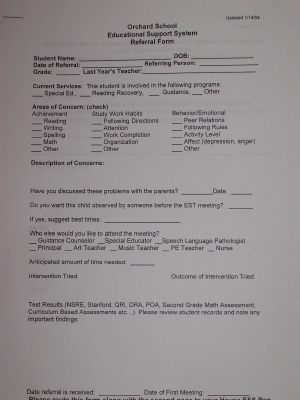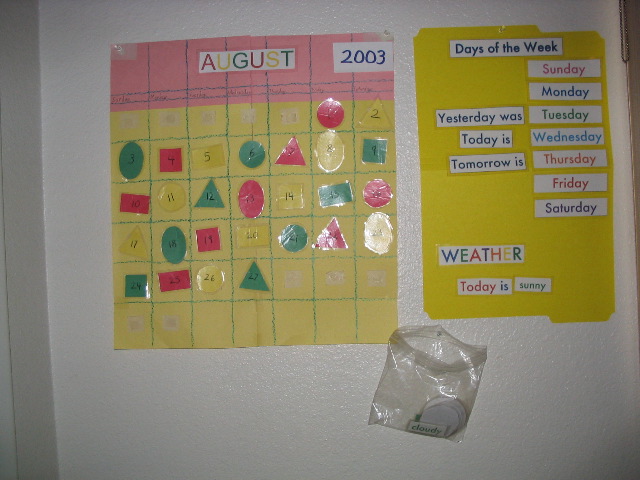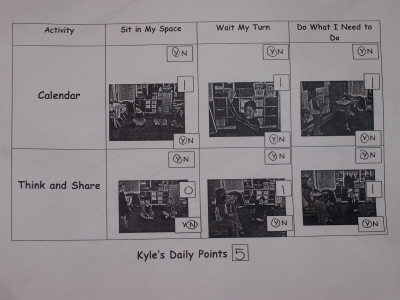| During my student teaching at Orchard Elementary
School I was blessed to work with 21 kindergarteners with varying abilities
and needs. At the point that I joined the classroom certain children
were ready to be assessed for special needs. At this school a child
usually has about 6 months of data collected before the teacher sends in
a request for assessment. A couple of months into my semester she
asked for Nate to be observed for certain behaviors such as not being able
to stay in his own space, not waiting his turn, and not doing what needs
to be done. |

|
The form to the left is an example of the Education Support System
form that is used at Orchard School. This form is filled out for
each child that is being referred to the ESS team. Each child has
a team that is selected by the teacher. This often includes parents
and teachers and anyone else that the teacher may check off. There
is also a place to check off what the child needs support with. Nate
had some study work habit and behavior marks checked off. |
| The picture to your right is of our calendar. This is a time
that is especially hard for Nate to sit still and do what he needs to do.
He is often calling out and moving into the center of our circle.
This is the time that one of our schools special educators came in to observe
Nate twice. From this she took notes to bring to the ESS meeting
with Nate's parents, herself, and my mentor teacher. Although I was
unable to go to the meeting as I was in charge of the classroom while my
mentor teacher was at the meeting we sat down and went through the minutes
of the meeting and what was going to happen. |
 |
 |
The chart to the left is what we came up with to help Nate.
During the week before the meeting we began to have Nate self-evaluate
how his day went on a scale from 1-10. This seemed to work pretty
well, so the meeting came up with this chart. The chart shows Nate
at two different times of the day: Calendar and Think and Share.
These two time were caused the most problems for Nate. The chart
asks him to evaluate how he does on three behaviors during these times
of the day. He self-evaluates how he thinks he did on those behaviors
and then the teacher gives her judgement. If both the teacher and the student
says "yes" that he followed the behavior then he gets a point. We
introduced the chart to Nate in a short meeting with the special educatior,
my mentor teacher, and myself. This allowed us to answer his questions
and it allowed him to approve or reject the idea. In the meeting
he told him what was expected of him in the activites, showed him the corresponding
pictures, and explained what he would be expected to do after the activities.
This helps Nate because it allows him to self-moniter his behavior
and helps him to be in charge of his day. In order to help Nate meet
his daily goal of 6 points. We are reminding him of what he needs to do
at the beginning of each day as well as chatting right after the activity
that he needs to self moniter. In time we will add more elements
of the day to the chart. |
| At the moment this plan is has been in effect for about
4 weeks. Nate's enthusiam for the chart is wonderful and he tries
very hard to get 6 points everyday, however, his behavior the rest of the
day isn't as good as he is not being rated those periods of the day.
This type of system will allow Nate to continue to learn and it will
help the other students by not being as distracted by his behavior (pc
3a: Every Child a Learner) during those times. At this point,
I believe that it is time to meet again to go over his chart and possibly
add a few more areas to help during other times of the day. As long
as we can keep Nate focused on his good behavior, he will do much better
each day. |
|